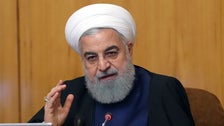
TEHRAN, Iran (AP) — Iran will break the uranium stockpile limit set by Tehran’s nuclear deal with world powers in the next 10 days, the spokesman for the country’s atomic agency said Monday while also warning that Iran has the need for uranium enriched up to 20%, just a step away from weapons-grade levels.
The announcement indicated Iran’s determination to break from the landmark 2015 accord, which has steadily unraveled since the Trump administration pulled America out of the deal last year and re-imposed tough economic sanctions on Iran, sending its economy into freefall.
The spokesman for Iran’s nuclear agency, Behrouz Kamalvandi, made the announcement during a press conference with local journalists at Iran’s Arak heavy water facility that was carried live on Iranian state television.
The development comes in the wake of suspected attacks on oil tankers last week in the region, attacks that Washington has blamed on Iran, and also as tensions have spiked between Iran and the United States, a year after President Donald Trump unilaterally withdrew America for the nuclear deal.
Kamalvandi acknowledged that the country already quadrupled its production of low-enriched uranium and said Tehran would increase uranium enrichment levels “based on the country’s needs.”
That increase could be to any level, from 3.67% which is the current limit set by the nuclear deal.
Iran’s needs 5% enrichment for its nuclear power plant in southern Iranian port of Bushehr and it also needs 20% enrichment for a Tehran research reactor, the spokesman said.
When uranium is mined, it typically has about 140 atoms of this unwanted isotope for every atom of U-235. Refining it to a purity of 3.67%, the level now allowed by the nuclear deal, means removing 114 unwanted atoms of U-238 for every atom of U-235.
Boosting its purity to 20% means removing 22 more unwanted isotopes per atom of U-235, while going from there to 90% purity means removing just four more per atom of U-235, he noted. Ninety percent is considered weapons-grade material.
That means going from 20% to 90% is a relatively quicker process, something that worries nuclear nonproliferation experts.
Gambrell reported from Dubai, United Arab Emirates.
REAL LIFE. REAL NEWS. REAL VOICES.
Help us tell more of the stories that matter from voices that too often remain unheard.
Credit: Source link